What the term "Split Face" actually means...
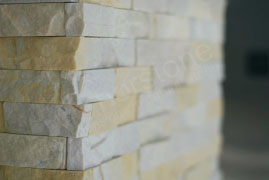 Split face is a broad term used in the building materials industry for any material that has been broken or split to expose a rougher surface. In the case of stone, the split face is desirable as it provides natural texture and stratification that is hard to duplicate outside of nature. Let’s take a closer look at how manufacturers achieve the split face look and why it can be a desirable finish.
Split face is a broad term used in the building materials industry for any material that has been broken or split to expose a rougher surface. In the case of stone, the split face is desirable as it provides natural texture and stratification that is hard to duplicate outside of nature. Let’s take a closer look at how manufacturers achieve the split face look and why it can be a desirable finish.
Natural stone is most often quarried in large pieces and then worked down through various means into the sizes and finishes desired. Primary and secondary cuts are most often made using band style diamond wire saws. Mechanical processing for the finish side of the stone will include the use of hydraulic splitters designed to break the stone along its natural cleavage lines, which creates the split face stone look that we are discussing today. Large mechanical polishers, grinders, tumblers, specialty saws, and even bush-hammer machines are examples of other equipment stone manufactures can use to create different finishes on the faces of stone as well. 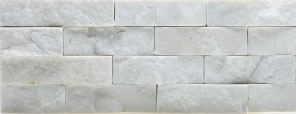
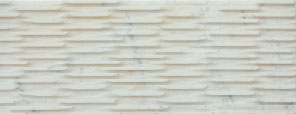 Above is an example of how the same raw stone can be manufactured into both a split face and sculptured finish, creating two completely different and unique looks and products.
Above is an example of how the same raw stone can be manufactured into both a split face and sculptured finish, creating two completely different and unique looks and products.
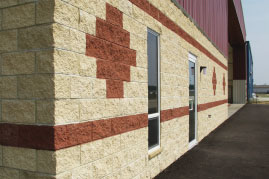 While the origin of the term split face is rooted in natural stone, the concrete masonry block industry is probably the most responsible for the proliferation of the split face term, particularly over the last 15-20 years. In the block industry, split face refers to a concrete block that has been split to expose a rough face. This rough face very loosely imitated stone masonry and was a popular building option for large commercial applications during the building boom of the 1990s and 2000s. The big benefit of split face masonry blocks is that they are cheap and quick and easy to install, and allowed builders to erect both the structural part of the wall and primary finish in one step. Split face masonry has fallen out of favor with some architects and builders as the product became so widely used projects started to lose their originality and other issues, like moisture seepage through the block, started cropping up as well.
While the origin of the term split face is rooted in natural stone, the concrete masonry block industry is probably the most responsible for the proliferation of the split face term, particularly over the last 15-20 years. In the block industry, split face refers to a concrete block that has been split to expose a rough face. This rough face very loosely imitated stone masonry and was a popular building option for large commercial applications during the building boom of the 1990s and 2000s. The big benefit of split face masonry blocks is that they are cheap and quick and easy to install, and allowed builders to erect both the structural part of the wall and primary finish in one step. Split face masonry has fallen out of favor with some architects and builders as the product became so widely used projects started to lose their originality and other issues, like moisture seepage through the block, started cropping up as well.
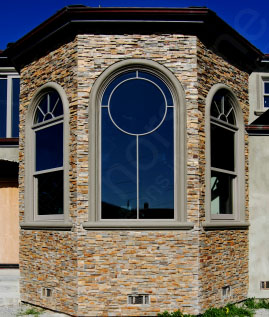 Split Face Natural Stone still remains a viable and desired finish option for projects ranging from the exteriors of residential and commercial applications to backsplashes and feature walls. Norstone Natural Stone Rock Panels and XL Series Rock Panels are great examples of a split face stone veneer product. The raw split face material is cut on the sides and back and then the individual stones are epoxied together in a 6”x24” panel unit. The panel concept allows for a quicker, standardized installation routine, while still achieving the timeless look of a natural split face stone wall. So whether you stumbled on this article researching natural stone or another product, consider the timeless look of split face stone to enhance your next wall veneer project.
Split Face Natural Stone still remains a viable and desired finish option for projects ranging from the exteriors of residential and commercial applications to backsplashes and feature walls. Norstone Natural Stone Rock Panels and XL Series Rock Panels are great examples of a split face stone veneer product. The raw split face material is cut on the sides and back and then the individual stones are epoxied together in a 6”x24” panel unit. The panel concept allows for a quicker, standardized installation routine, while still achieving the timeless look of a natural split face stone wall. So whether you stumbled on this article researching natural stone or another product, consider the timeless look of split face stone to enhance your next wall veneer project.
.png)




